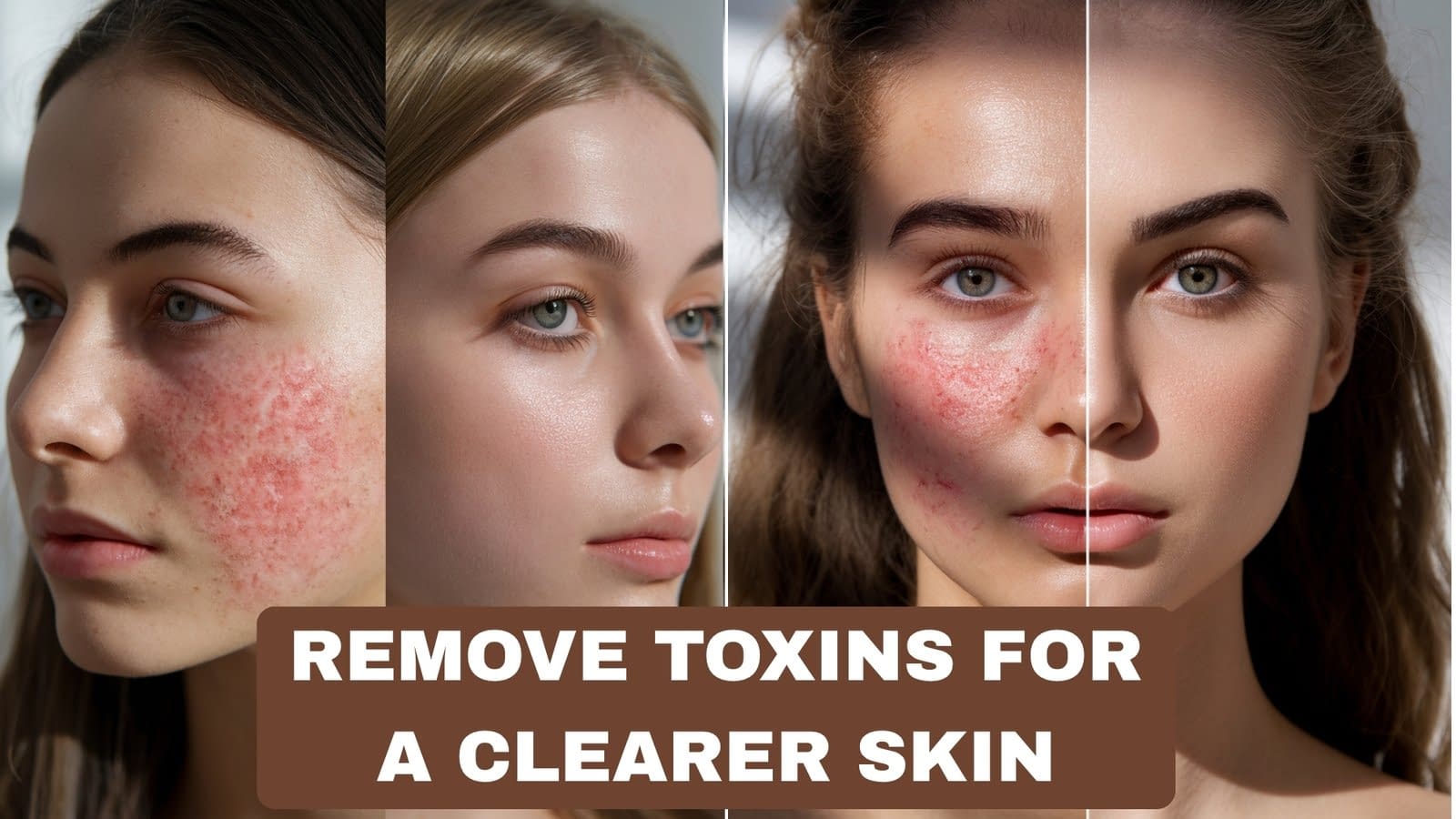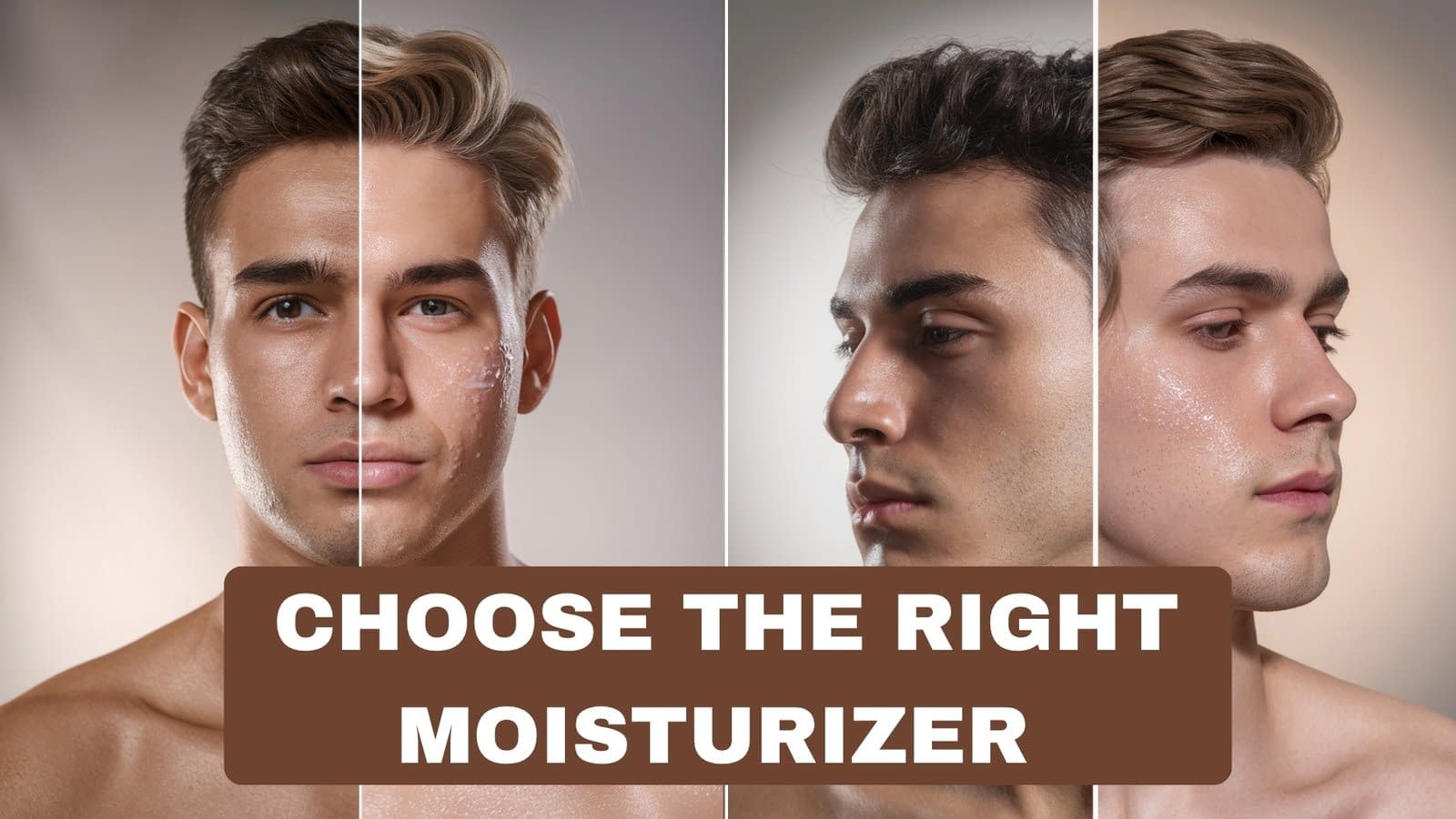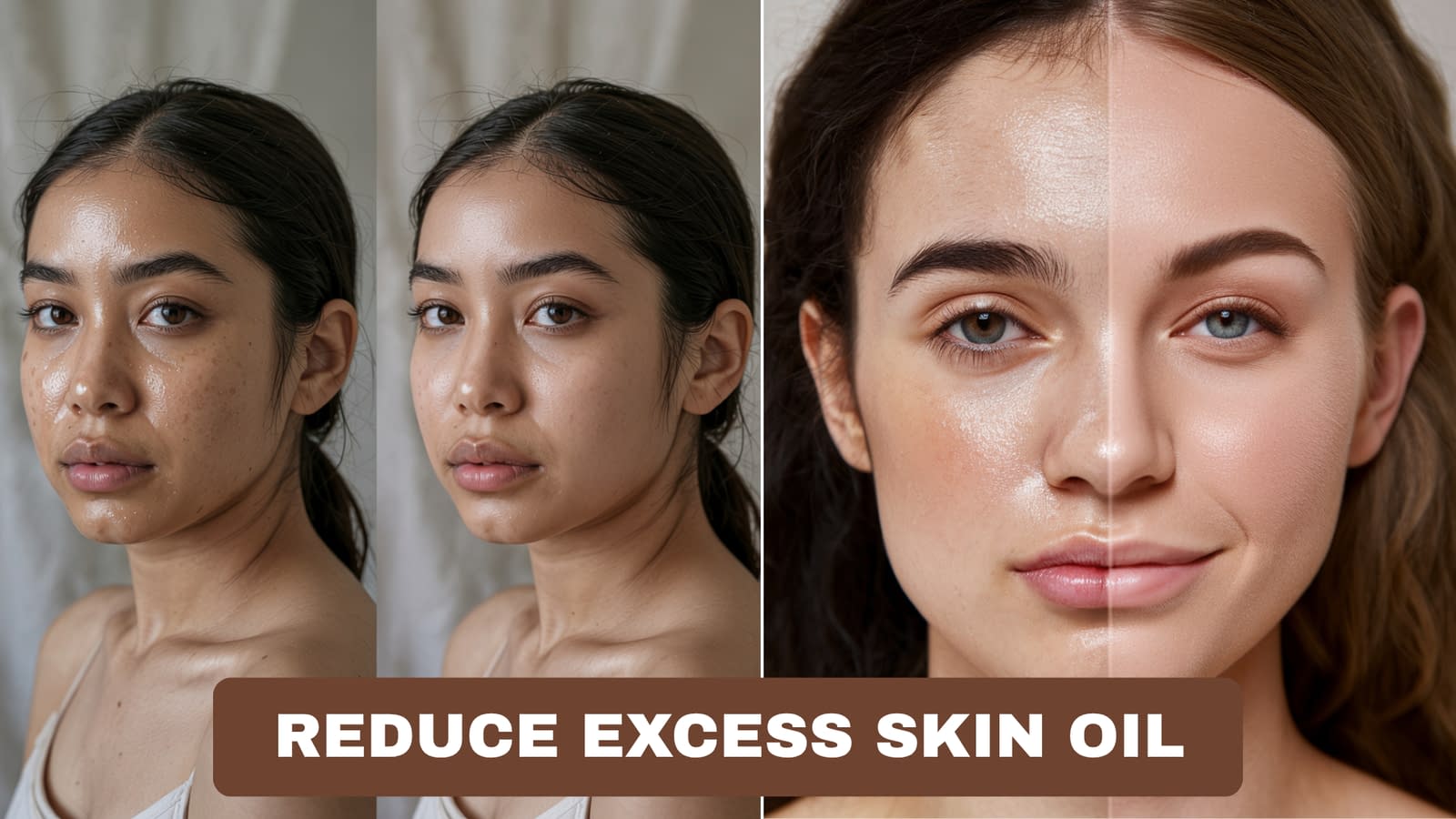Beard itch and flakes are annoying, uncomfortable, and — for many — a confidence-killer. The good news: most causes are easy to identify and fix with a consistent, gentle routine. This guide walks you through why it happens, exactly what to do (step-by-step), natural remedies, product guidance, grooming habits, diet and when to see a pro. Read the sections that matter to you or follow the whole plan and stop suffering from beard itch for good.
Why Does Your Beard Itch? Common Causes Explained
Beard itch is a symptom, not a diagnosis. The same scratchy feeling can come from several things:
- Dry skin beneath the beard. Lack of oil and moisture → tight, itchy skin.
- New beard growth (the stubble stage): short, stiff hairs poke the skin and produce irritation.
- Skin irritation from harsh soaps, fragrances, aftershaves, or poorly rinsed products.
- Poor grooming — long buildup of sebum, dirt and dead skin causes friction and itch.
- Allergic contact dermatitis — you may react to an ingredient (fragrance, preservative, plant extract).
- Skin conditions such as seborrheic dermatitis (beard dandruff), eczema, or fungal infections — these need targeted treatment.
- Environmental factors (cold/dry air) that strip moisture from both hair and skin.
- Hormonal or nutritional factors (less common) that affect skin barrier or hair growth.
How to tell the difference (quick check):
- If itch appears when beard is growing out and improves with trimming → likely new-growth irritation.
- If you have white flakes with oily skin or red patches → think seborrheic dermatitis.
- If you started a new product and itch followed within days → suspect allergic or irritant contact dermatitis.
The Connection Between Beard Flakiness and Skin Health
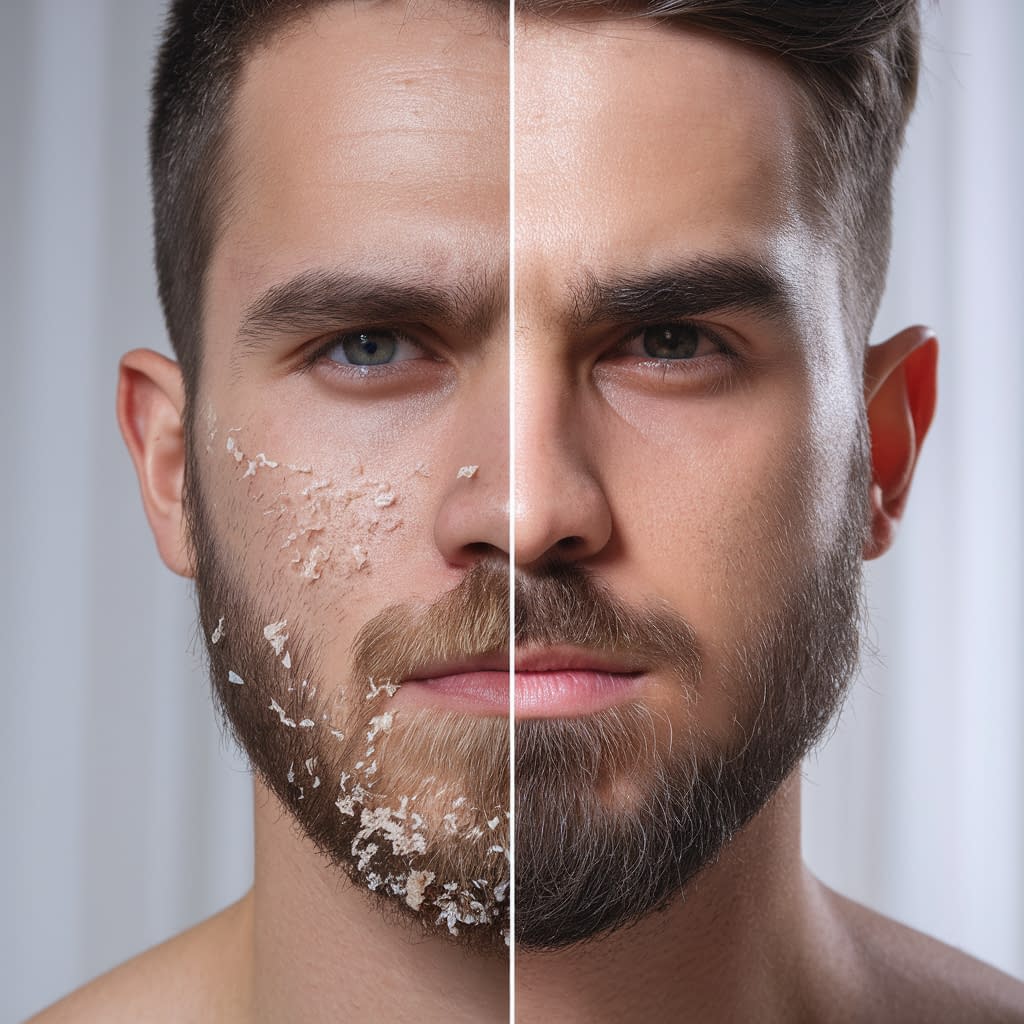
Flakes in your beard (beard dandruff) are dead skin cells piling up. Healthy skin naturally sheds tiny amounts of cells — too much shedding or poor removal equals visible flakes.
Primary reasons flakes appear:
- Dryness: skin lacking lipids sheds more visible scales.
- Overproduction of oil + Malassezia yeast: in seborrheic dermatitis the skin is oily but flaky because yeast and inflammation accelerate shedding.
- Irritation from ingredients: alcohol, strong fragrances, or surfactants strip oils and cause rebound flaking.
- Insufficient cleansing or exfoliation: flakes accumulate, mat with beard oils and look worse.
Goal for healthy skin under the beard: restore barrier function (moisture + lipids), control inflammation and reduce yeast/overgrowth where present — but gently, not aggressively.
How to Deal With Beard Itch During Early Growth Stages
That “itchy as hell” 1–4 week phase when you’re growing a new beard is normal. Here’s how to survive it—and keep your skin comfortable.
Step-by-step starter plan (first 8 weeks):
- Keep it short and trimmed at first if itch is unbearable. Sharp stubble is what pokes skin most — trimming to a uniform short length reduces poking.
- Cleanse daily but gently. Use a mild, sulfate-free beard shampoo or a gentle cleanser; don’t over-wash (see section 7).
- Moisturize immediately after washing. Apply a light, non-comedogenic beard oil or lightweight moisturizer while the skin is slightly damp (it locks moisture in).
- Brush with a soft boar brush once daily — it helps train hairs down, exfoliates flakes and distributes oils from roots to tips.
- Use a weekly salt or sugar scrub on the beard base for 1–2 minutes (gentle circular motions) to remove dead skin and ingrown hairs — do not scrub raw skin.
- Apply an anti-itch balm at night: a thin layer of jojoba/argan oil or aloe-based gel calms irritation overnight.
Extra tips for new-grow discomfort:
- Try a warm compress (30–60 seconds) to soften skin before moisturizing.
- Avoid heavy balms that mat new hairs down; choose lighter oils until the beard fills out.
The Role of Exfoliation in Preventing Beard Flakes
Exfoliation removes dead skin, decreases flakes and helps prevent ingrown hairs. But with facial skin you must be gentle.
Types of exfoliation
- Physical (mechanical): soft brush, washcloth, or gentle scrub (sugar, very fine salt, oatmeal).
- Chemical: low-strength AHA (lactic, glycolic) or BHA (salicylic acid). BHA is particularly useful because it dissolves oil inside follicles and reduces clogged pores.
How to exfoliate safely — step-by-step:
- Frequency: 1× to 2× per week for most men. If you have sensitive or inflamed skin, start with once every 10 days.
- Mechanical method:
- After a warm shower, use a soft boar-bristle brush or a washcloth.
- Apply gentle circular strokes for 30–90 seconds across the beard area.
- Rinse and follow with moisturizer.
- Chemical method (preferred for follicle issues):
- Use a low-concentration BHA product (e.g., 1–2% salicylic acid) or a mild lactic acid toner (5–10%).
- Patch test first. Apply after cleansing, leave on per product instructions, and moisturize.
- Start once per week and increase slowly only if your skin tolerates it.
- Avoid combining strong chemical exfoliants with physical scrubs the same day — that can over-exfoliate and damage the barrier.
Warning signs of over-exfoliation: burning, stinging, increased redness, raw or tight sensations. Stop immediately and soothe skin with barrier-repair products (ceramides, glycerin, niacinamide).
Essential Beard Care Routine to Stop Itch and Flakes
A reliable daily and weekly routine will eliminate most beard itch and flakiness.
Daily routine (morning & night)
Morning
- Rinse or cleanse with lukewarm water or a gentle beard shampoo (if you sweat during sleep).
- Pat dry gently — don’t rub.
- Apply a hydrating product: a few drops of beard oil or a light leave-in conditioner (apply to skin first, then comb through hair).
- Comb/brush with a boar brush to distribute oils and smooth hairs.
Night
- Cleanse only if needed (daily gentle cleanse is fine).
- Apply a thicker beard balm or oil if skin is dry — again, skin-first application.
- Comb to ensure product reaches skin and hair base.
Weekly routine
- Exfoliate 1–2× with either mechanical or chemical method (see section 4).
- Deep condition: apply a hot-towel treatment with a natural oil (coconut/jojoba) once weekly for 10–15 minutes if hair is dry.
- Trim to maintain shape and prevent split ends that cause rubbing and irritation.
Morning-to-night product application (simple formula)
- Cleanser → Toner/essence (optional) → Oil/serum to skin → Light balm to hair if needed → Brush/combe.
Best Natural Remedies to Soothe Beard Itch

Natural oils and extracts can be very effective — but use them correctly and patch-test.
Top proven natural options
- Jojoba oil — structurally similar to skin sebum, non-comedogenic, excellent for sealing moisture without feeling greasy.
- Argan oil — rich in vitamin E and fatty acids; good for hair softness.
- Coconut oil — great antimicrobial properties; caution: can clog pores for some (test first).
- Aloe vera gel — cooling, soothing, good for inflamed or sun-exposed skin.
- Tea tree oil — antimicrobial and anti-fungal; effective against mild dandruff/yeast issues — must be diluted.
- Shea butter — thick balm ingredient for night-time barrier repair.
- Honey (Manuka) — used occasionally in masks for antimicrobial and humectant properties.
Simple DIY calming oil blend (example & safety)
- Carrier oil base: 30 ml jojoba oil.
- Add tea tree essential oil at 0.5% concentration as an option for dandruff-prone skin.
- Calculation: 0.5% of 30 ml = 30 × 0.005 = 0.15 ml (≈ 3 drops if 1 drop ≈ 0.05 ml).
- So for a 30 ml bottle, add about 3 drops of tea tree.
- Optional: add 6–9 drops total lavender essential oil for scent and calming effect (do not exceed safe dilution and patch-test).
How to use the DIY blend: apply 2–3 drops to fingertips, rub between hands, press into skin under beard once a day. Patch-test 24–48 hours.
Important safety notes:
- Always do a patch test 24–48 hours before using a new oil mix.
- Essential oils must be diluted — avoid using them neat on face.
- If you’re acne-prone, start with non-comedogenic carriers (jojoba, grapeseed).
Choosing the Right Beard Shampoo and Conditioner
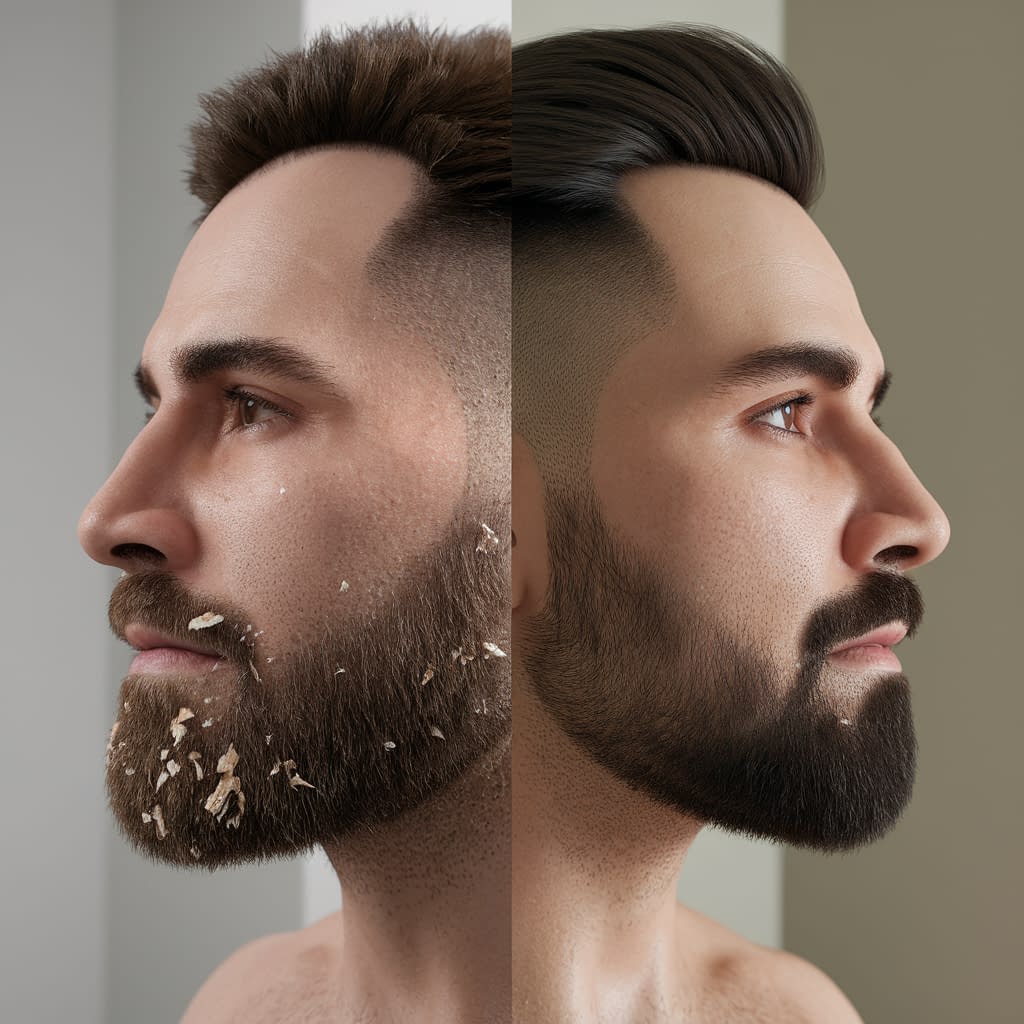
Not all “beard shampoos” are created equal. Choose formulas that cleanse but don’t strip.
What to look for
- Sulfate-free (avoid sodium lauryl sulfate) — too harsh and drying.
- Mild surfactants (coco-glucoside, decyl glucoside, sodium cocoyl isethionate).
- Humectants & emollients: glycerin, panthenol, natural oils.
- Anti-dandruff actives (if flakes present): zinc pyrithione, selenium sulfide, or ketoconazole — rotate or use as directed for seborrheic dermatitis.
- Fragrance-free or lightly fragranced if you have sensitive skin.
- pH-balanced formulas (facial skin likes slightly acidic pH).
Shampoo & conditioner regimen—step-by-step:
- Wash 2–3× per week with a gentle beard shampoo for most men; daily washing may be OK if the formula is mild and you shampoo lightly.
- Massage shampoo into skin (not just hair) for 30–60 seconds to lift flakes and oil. Rinse thoroughly.
- Condition: use a small amount of beard conditioner or a lightweight hair conditioner; focus on hair shaft, briefly leave 1–2 minutes, then rinse.
- Dry and oil: pat dry and apply a few drops of oil to skin then comb through hair.
When to use medicated anti-dandruff shampoo: if you see persistent oily flakes or red patches, try ketoconazole 1% (OTC in many countries) or zinc pyrithione shampoos twice a week for 4–6 weeks; consult a dermatologist if no improvement.
Beard Oils and Balms: Your Secret to a Soft, Flake-Free Beard
Beard oils and balms do three important things:
- Moisturize the skin beneath the hair (prevent dryness).
- Soften hair shafts, reducing mechanical friction and itch.
- Create a light protective barrier to lock in moisture.
How to apply oil & balm correctly (step-by-step):
- After showering when the skin is slightly damp, pour 2–6 drops (depending on beard length) into palm.
- Short stubble: 1–2 drops.
- Short beard (1–2 inches): 3–5 drops.
- Long beard: 6–10 drops.
- Rub hands together and apply to the skin first — press fingertips into the skin under the beard along jawline and cheeks.
- Comb through hair with a wide-tooth comb or brush to evenly distribute oil.
- If using balm, scoop a small amount, warm between fingers and apply to hair for hold and added conditioning.
Choosing oil ingredients
- Carrier oils: jojoba, argan, sweet almond, grapeseed are good choices.
- Additives: vitamin E (small %), a tiny amount of tea tree if balancing yeast (dilute carefully).
- Avoid heavy mineral oil (pore-clogging) and alcohol-containing products that dry skin.
Frequency: daily or every other day depending on skin dryness.
Grooming Habits That Prevent Itch Before It Starts

Good habits make the difference between a comfy beard and a miserable one.
Daily habits
- Brush/comb daily with a boar brush or wide-tooth comb to distribute oils and remove tiny flakes.
- Rinse after sweaty sessions: salt from sweat can irritate. Quick rinse and reapply small oil if needed.
- Don’t over-wash: strips natural oils; use a gentle routine.
Weekly/monthly
- Trim split ends and shape to reduce rubbing and snagging (every 3–6 weeks for longer beards).
- Deep condition weekly with warm oil treatment (wrap a warm towel for 10–15 mins).
- Replace razors/blades often if you shave neck/cheeks — dull blades irritate.
Tool hygiene
- Clean your combs and brushes weekly with warm water and mild soap; let them dry fully. Dirty brushes re-deposit oils and skin cells.
Common Beard Care Mistakes That Make Itch and Flakes Worse
Avoid these frequent mistakes:
- Using bar soap or harsh shampoo — they strip oils and damage the barrier.
- Over-exfoliating — too much scrubbing leads to raw, reactive skin.
- Applying oil to dirty skin — it traps sweat/debris and can worsen flakes or acne.
- Heavy fragrance and alcohol-based aftershaves — they sting and dry the skin.
- Sleeping on dirty pillowcases — change weekly; oils and microbes transfer back to skin.
- Neglecting patch testing when adding essential oils or new active products.
Diet and Hydration Tips for Healthier Skin and Beard

Skin and hair health reflect what you feed the body.
Hydration
- Drink steadily across the day; aim for a baseline of ~1.5–2 L / day (adjust for activity & climate). Hydrated skin flakes less.
Key nutrients
- Omega-3 fatty acids (fatty fish, flax, chia) reduce inflammation and support skin lipid barrier.
- Protein (lean meats, legumes) supplies the building blocks for hair keratin.
- Zinc (pumpkin seeds, legumes) supports skin healing and oil regulation.
- Vitamin D (sun or supplements) can help with inflammatory skin disorders.
- Antioxidants (berries, leafy greens) reduce oxidative stress on skin.
Avoid in excess
- High sugar and refined carbs — they can increase inflammation and worsen dandruff in some people.
- Excess alcohol — dehydrates skin.
If you suspect deficiencies, consult your healthcare provider and consider basic blood tests (iron, vitamin D, zinc) before supplementing blindly.
When to See a Dermatologist About Beard Itch
Most beard itch resolves with good care. See a dermatologist if:
- Itch persists despite 4–8 weeks of good care (wash+moisturize+exfoliate).
- Worsening redness, swelling, oozing, or painful patches (possible infection).
- Large yellow/orange flakes, intensely oily scales or thick crusts — could be seborrheic dermatitis or psoriasis.
- Small pimple-like bumps that spread — suspect folliculitis or fungal infection.
- You have signs of an allergic reaction (intense burning, swelling) after new product.
What a dermatologist may do: examine skin, perform KOH microscopy or fungal swab, prescribe medicated shampoos (ketoconazole, selenium sulfide), topical steroids for inflammation (short-term), topical antifungals or oral treatments for persistent infections, and offer patch testing for contact allergies.
Final Words
Beard itch and flakiness are almost always fixable — but the fix is consistent habits more than miracle products. Here’s a simple plan to follow:
Daily: gentle cleanse as needed → apply a few drops of oil to skin → brush/comb.
Weekly: exfoliate 1×, deep-condition 1×, trim irregular edges.
Monthly: reassess products (cut out anything irritating), replace razor blades and clean tools.
Quick 5-step emergency relief (do this today):
- Rinse beard with warm water and a gentle cleanser.
- Pat dry and apply 2–4 drops of jojoba oil to the skin under beard.
- Gently brush to distribute oil and loosen flakes.
- If flakes look oily and yellow, try a medicated anti-dandruff shampoo once (zinc pyrithione or ketoconazole).
- If severe redness or pain occurs, book a dermatologist visit.
Be patient — skin turnover takes time (usually 4–8 weeks) to normalize. With the right cleansing, regular gentle exfoliation, targeted moisture and sound grooming, itch and flakes should become a memory.



